Lumines Electronic Symphony Review
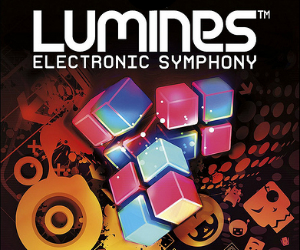 Game: Lumines Electronic Symphony
Game: Lumines Electronic Symphony
Developer: Q Entertainment
Publisher: Ubisoft
Available on: PlayStation Vita only
Q Entertainment has long understood how to create an experience that is not so much a mere game, but a full-on assault on the senses. Whether you are talking about the sublime likes of Every Extend Extra, the mind-blowing Child of Eden, or their co-production efforts in bringing classics like Gunpey to alternative platforms, their output always comes with a profound grasp of how elements such as music, rhythm and mood can be harnessed into an immensely satisfying whole. It is no surprise to find out that their founding member was one of the key players behind SEGA’s Dreamcast successes Rez and Space Channel 5, and much like that other magical developer Treasure, who formed after breaking away from their own parent company, Q arrived fully-formed, opening their account with a title that has gone on to be regarded as an all-time classic. Their Gunstar Heroes was PSP launch puzzler Lumines.
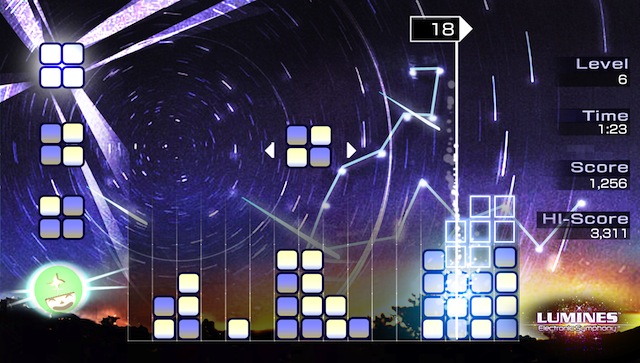
While ostensibly a Tetris-style puzzle game, Lumines fused the block-busting game mechanic with a banging Mondo Grosso electronic soundtrack and gameplay that gradually evolves, the “skins” or backgrounds and colour schemes of the blocks changing over time, the more that you eliminate from the playing field. The soundtrack directly affects the way you play, the faster the track, the more difficult it is to chain combos together. The slower the groove, the less frequently the block-sweeping “timeline” passes across the screen, leading to slower block clearage.
Lumines was the quintessential launch game, and even a sequel for the PSP did not usurp the purity and magical qualities of its predecessor, which still ranks as one of the principle reasons to own the console. There have been several attempts to re-tool the game for other platforms, but in my eyes none have come close to the magnificence of firing up the 2004 UMD, hearing the familiar “Shinin’” tune, and settling in for a session. Until now, maybe?
Here we are, at the launch of Sony’s new handheld. A new Lumines would appear to be the perfect fit for a launch game, something that Ubisoft have picked up on, offering Lumines Electronic Symphony as part of their opening Vita salvo. The question is, does it have the same magical properties that kept me playing the original for eight years, or is it destined to be a disappointment like the recent mobile phone versions?
GRAPHICS: Blocks fall down from the top of the screen, 3D-styled as opposed to the 2D sprites of the original, in a simple dual colour scheme. You begin with classic red and white, against a fairly mundane backdrop, but the more you play, the more trippy things get, the colour schemes and form of the blocks change, and you feel yourself immersed not only by the pulsating music, but by the beautiful visual spectacle unfolding before your eyes. Blocks explode in shimmering mini-firework displays, tracers of light dance across the screen, and mystifying patterns swirl underneath the playing field. It looks stunning.
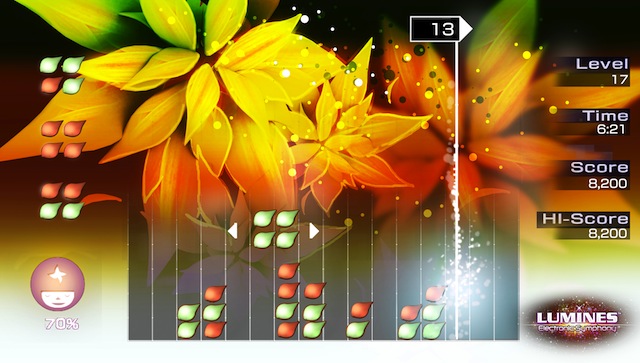
SOUND: Mondo Grosso are sadly absent from proceedings, but that doesn’t spell disaster. Q have once again shown a mastery of incorporating dazzling electronica into the heart of their game. You are guided into the fray by the graceful slow-build of Everything But The Girl’s Deep Dish-featuring classic “The Future of The Future (Stay Gold)”; which gradually rises to a crescendo before introducing Tracey Thorn’s signature mournful vocal. It is an incredible way to begin, and makes you appreciate that there is a great deal more to EBTG than just “Missing”, but also that this is a god-damn Lumines! Blending smoothly with the sound effects and never missing a beat, the soundtrack brings together a stellar array of musical talent from past a present. It reads like Who’s Who? of important contributors to the dance scene, taking in such luminaries as 80’s pioneers 808 State, crossover megastars The Chemical Brothers, the pre-eminent electronic act of the 2000’s, LCD Soundsystem, Cornish nutcase Aphex Twin, and Winehouse production supremo Mark Ronson. Each track offers a different tempo, you can imagine how insane things get during “Windowlicker” for example. The overall selection is far superior to the last “true” Lumines sequel, which included crap like the Black Eyed Peas or inappropriate use of otherwise worthwhile artists like Missy Elliott and Gwen Stefani; completely at odds with the spirit of the series. Indeed, the 34 tracks here offer not one duffer amongst them, and would work just as well as a standalone playlist; it is that damn good.
GAMEPLAY: It says a great deal that I inserted the card, installed the game, and began playing the main “Voyage” mode, and was still sat there, in a trance-like state, 45 minutes later. The logo on the cutesy wee Vita box may have changed, the console may be different, but this is vintage Lumines, with a couple of twists that freshen up the formula without diluting the essence of what made the original such a blinder. The aim is still the same, rotate and drop blocks to form clumps of four or more, which are then eliminated by the ever sweeping timeline. Occasionally a different type of block will appear that will eliminate every block of the same colour that it touches, creating chains and combos and racking up your score. There is a new shuffle block which completely randomises every block connected to wherever it is placed, which can be a help or a hindrance, and lends an element of chance to things.
An avatar sits at the side of the screen, only this time around you interact with the little fella far more than in previous incarnations. During play, you have a meter which is filled either by dropping blocks or by tapping on the rear touch pad of the console. This may seem a bit foreign at first, but give it time and you will learn that you can tickle the back of your Vita in time to the music, should you wish. Once the meter is full to the brim, your avatar can unleash a special ability to help you along your way. There are several outcomes, such as halting the timeline temporarily to assist setting up a sweet chain combo, offering up a much needed chain block. Of course, you don’t have to worry about tapping, or indeed watching the meter, if you don’t want to, as the assists come automatically and can be taken as being almost entirely random.
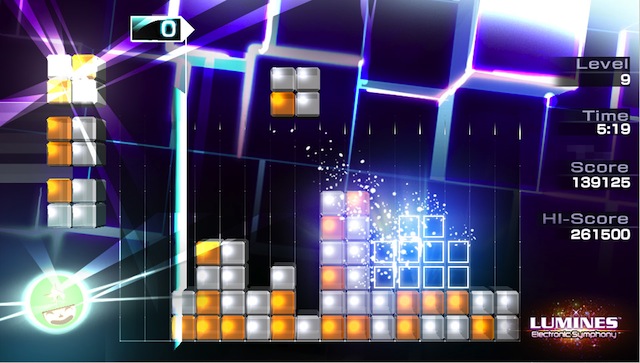
The only other thing that is radically different about the core of the game is that you can now use the touch screen to play. Personally speaking I feel that this works better using the classic control scheme, but the touch controls are well implemented, and people used to playing with your iPads, you just may want to use your digits here too.
Voyage mode is fantastic on its own, but there other ways to play. You can go up against the clock to maximise your score within a designated time period. You can battle your friends in ad-hoc mode in a spin on the Tetris Battle Gaiden/Super Puzzle Fighter template. You can even create your own “Playlist” by choosing the order in which the skins appear, depending on which you have unlocked. The more you play, the more you build up XP, which in turn allows you to unlock new skins and avatars.
MULTIPLAYER: Leaderboards are present, and your scores are instantly compared to your friends. There is support for ad-hoc contests too, but by far the most interesting side of the online functionality is the “World Block” feature. Designed to encourage participation from the online Lumines community, World Block counts up all of the blocks cleared by participants around the world over a 24 hour period, and erases them from a collective “World Block”. As a reward, everyone who takes part earns themselves some XP; how cool is that?
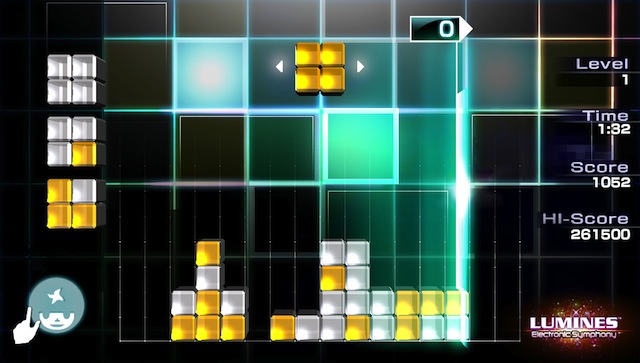
LONGEVITY: Lumines lasted me eight bloody years last time around, I even recall taking part in a frantic weekend mercy dash to procure a new PSP charger a few years back just to satisfy my fix, and early impressions with this seem just as good. There aren’t the same plethora of modes as you would find on a Tetris DS, however does Lumines really need gimmicky minigames and different ways to play, when the Voyage and Playlist options are so damn fine?
VERDICT: In 2004 Lumines was a must have launch title, in something of a barren launch line-up (Kao Challengers?! Dead To Rights: Reckoning? *pukes*). Lumines Electronic Symphony is another cracking day one release, amidst what is turning out to be a selection of opening day corkers. It instantly becomes the second greatest version of the game Q have yet produced. I think the inclusion of the shuffle block, which will upset some fans, and the whole tapping thing just about justify the docked mark that would have put it right up there with the original, but don’t let that statement put you off in any way, shape or form, this is a brilliant puzzler that any fan of the genre who has adopted the PS Vita needs to own.





